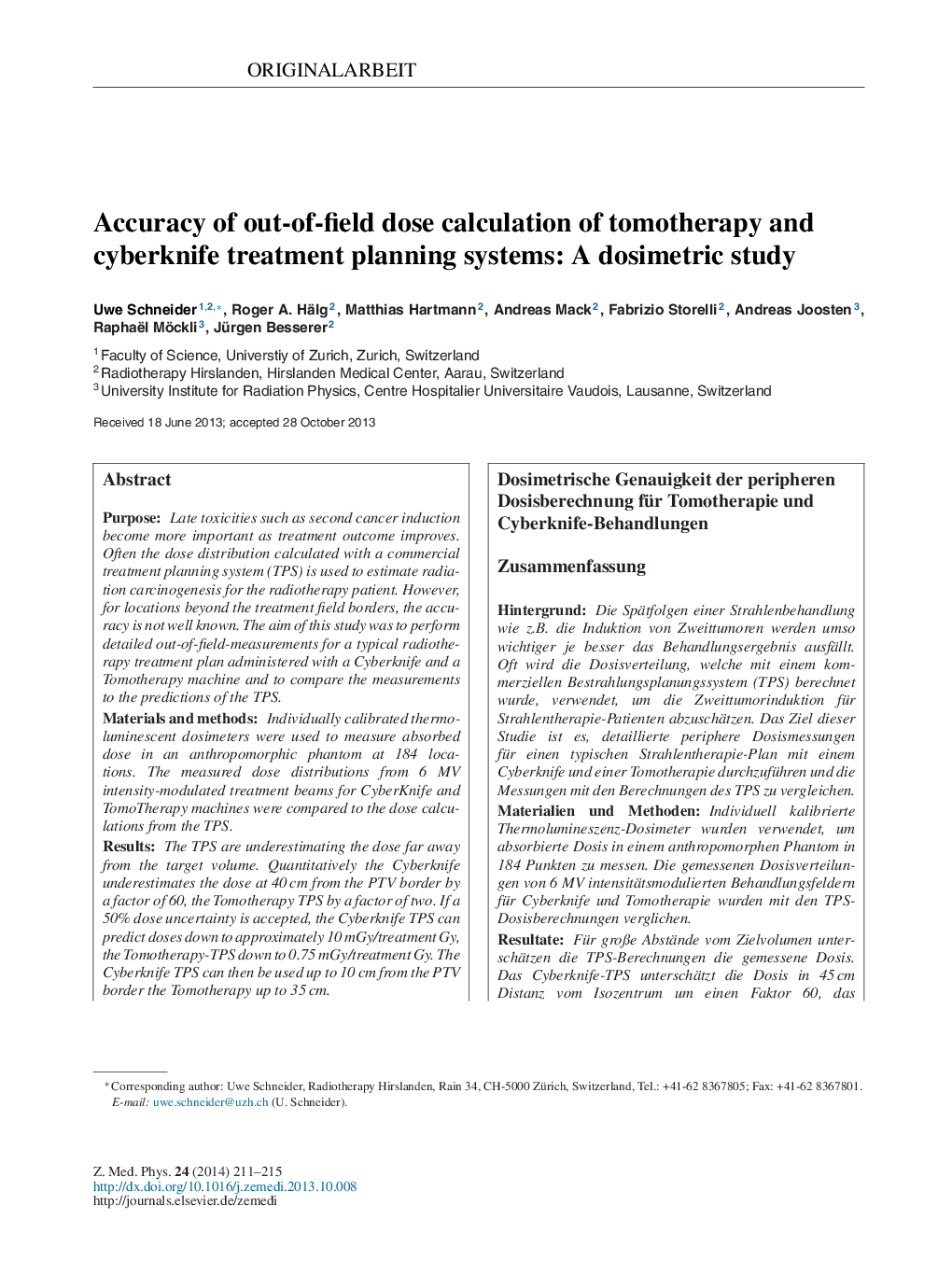| کد مقاله | کد نشریه | سال انتشار | مقاله انگلیسی | نسخه تمام متن |
|---|---|---|---|---|
| 1887980 | 1043646 | 2014 | 5 صفحه PDF | دانلود رایگان |
PurposeLate toxicities such as second cancer induction become more important as treatment outcome improves. Often the dose distribution calculated with a commercial treatment planning system (TPS) is used to estimate radiation carcinogenesis for the radiotherapy patient. However, for locations beyond the treatment field borders, the accuracy is not well known. The aim of this study was to perform detailed out-of-field-measurements for a typical radiotherapy treatment plan administered with a Cyberknife and a Tomotherapy machine and to compare the measurements to the predictions of the TPS.Materials and methodsIndividually calibrated thermoluminescent dosimeters were used to measure absorbed dose in an anthropomorphic phantom at 184 locations. The measured dose distributions from 6 MV intensity-modulated treatment beams for CyberKnife and TomoTherapy machines were compared to the dose calculations from the TPS.ResultsThe TPS are underestimating the dose far away from the target volume. Quantitatively the Cyberknife underestimates the dose at 40 cm from the PTV border by a factor of 60, the Tomotherapy TPS by a factor of two. If a 50% dose uncertainty is accepted, the Cyberknife TPS can predict doses down to approximately 10 mGy/treatment Gy, the Tomotherapy-TPS down to 0.75 mGy/treatment Gy. The Cyberknife TPS can then be used up to 10 cm from the PTV border the Tomotherapy up to 35 cm.ConclusionsWe determined that the Cyberknife and Tomotherapy TPS underestimate substantially the doses far away from the treated volume. It is recommended not to use out-of-field doses from the Cyberknife TPS for applications like modeling of second cancer induction. The Tomotherapy TPS can be used up to 35 cm from the PTV border (for a 390 cm3 large PTV).
ZusammenfassungHintergrundDie Spätfolgen einer Strahlenbehandlung wie z.B. die Induktion von Zweittumoren werden umso wichtiger je besser das Behandlungsergebnis ausfällt. Oft wird die Dosisverteilung, welche mit einem kommerziellen Bestrahlungsplanungssystem (TPS) berechnet wurde, verwendet, um die Zweittumorinduktion für Strahlentherapie-Patienten abzuschätzen. Das Ziel dieser Studie ist es, detaillierte periphere Dosismessungen für einen typischen Strahlentherapie-Plan mit einem Cyberknife und einer Tomotherapie durchzuführen und die Messungen mit den Berechnungen des TPS zu vergleichen.Materialien und MethodenIndividuell kalibrierte Thermolumineszenz-Dosimeter wurden verwendet, um absorbierte Dosis in einem anthropomorphen Phantom in 184 Punkten zu messen. Die gemessenen Dosisverteilungen von 6 MV intensitätsmodulierten Behandlungsfeldern für Cyberknife und Tomotherapie wurden mit den TPS-Dosisberechnungen verglichen.ResultateFür große Abstände vom Zielvolumen unterschätzen die TPS-Berechnungen die gemessene Dosis. Das Cyberknife-TPS unterschätzt die Dosis in 45 cm Distanz vom Isozentrum um einen Faktor 60, das Tomotherapie-TPS um den Faktor zwei. Bei Akzeptanz einer 50%-igen Dosisunsicherheit kann das Cyberknife-TPS minimale Dosen bis etwa 10 mGy/Behandlungs-Gy vorhersagen, das Tomotherapie-TPS ca. 0,75 mGy/Behandlungs-Gy. Das Cyberknife-TPS kann deshalb bis zu einer Distanz von ca. 10 cm zum PTV-Rand verwendet werden und die Tomotherapie bis zu ca. 35 cm.ZusammenfassungDie Berechungen des Cyberknife- und des Tomotherapy-TPS unterschätzen periphere Dosen. Für die Abschätzung der Zweittumorinzidenz für die Cyberknife-Therapie sollte man sich nicht auf die vom TPS berechneten Dosen verlassen. Dosisberechnugen des Tomotherapy-TPS können bis zu einer Distanz von ca. 35 cm vom PTV-Rand verwendet werden (für ein 390 cm3 großes PTV).
Journal: Zeitschrift für Medizinische Physik - Volume 24, Issue 3, September 2014, Pages 211–215
